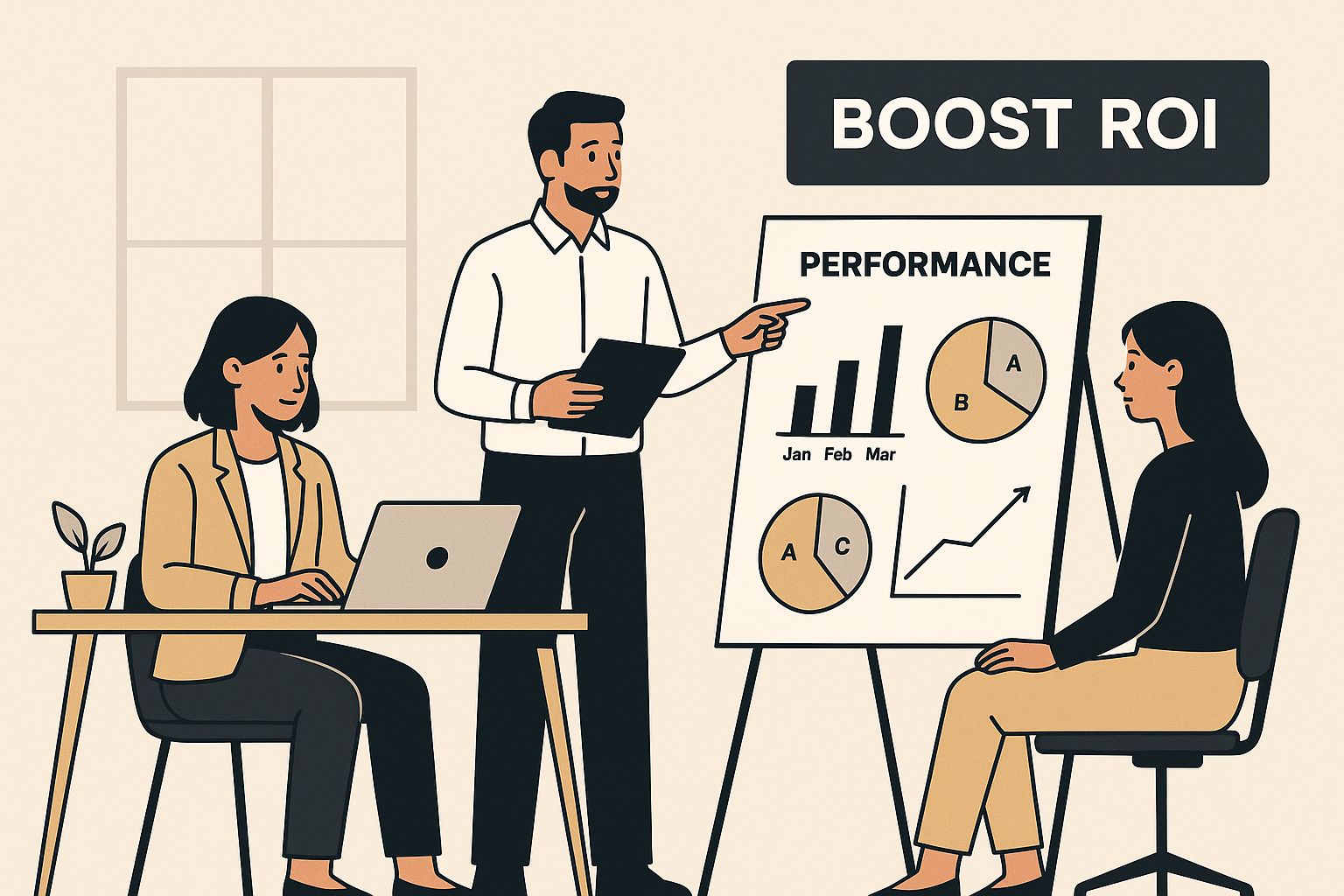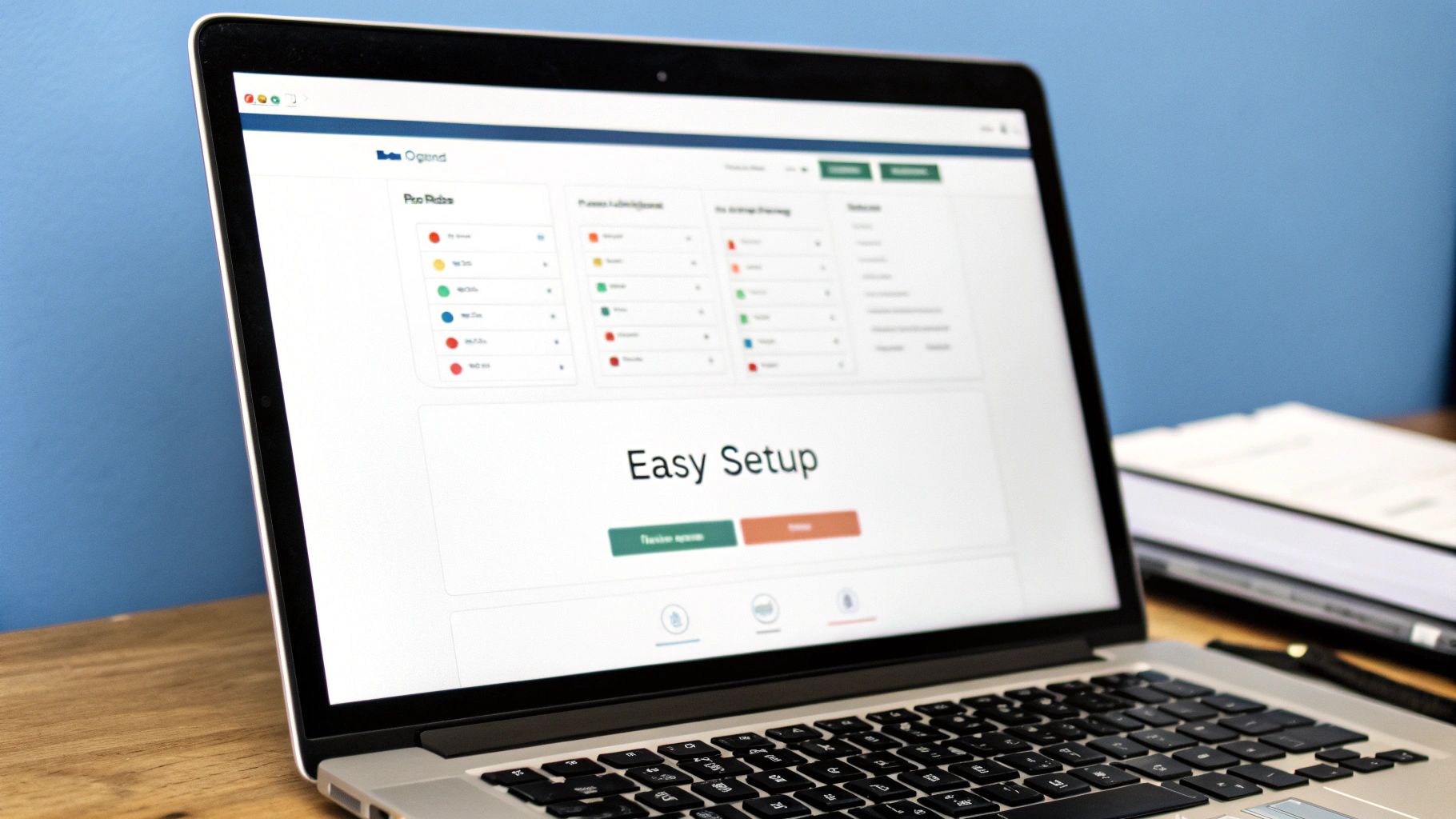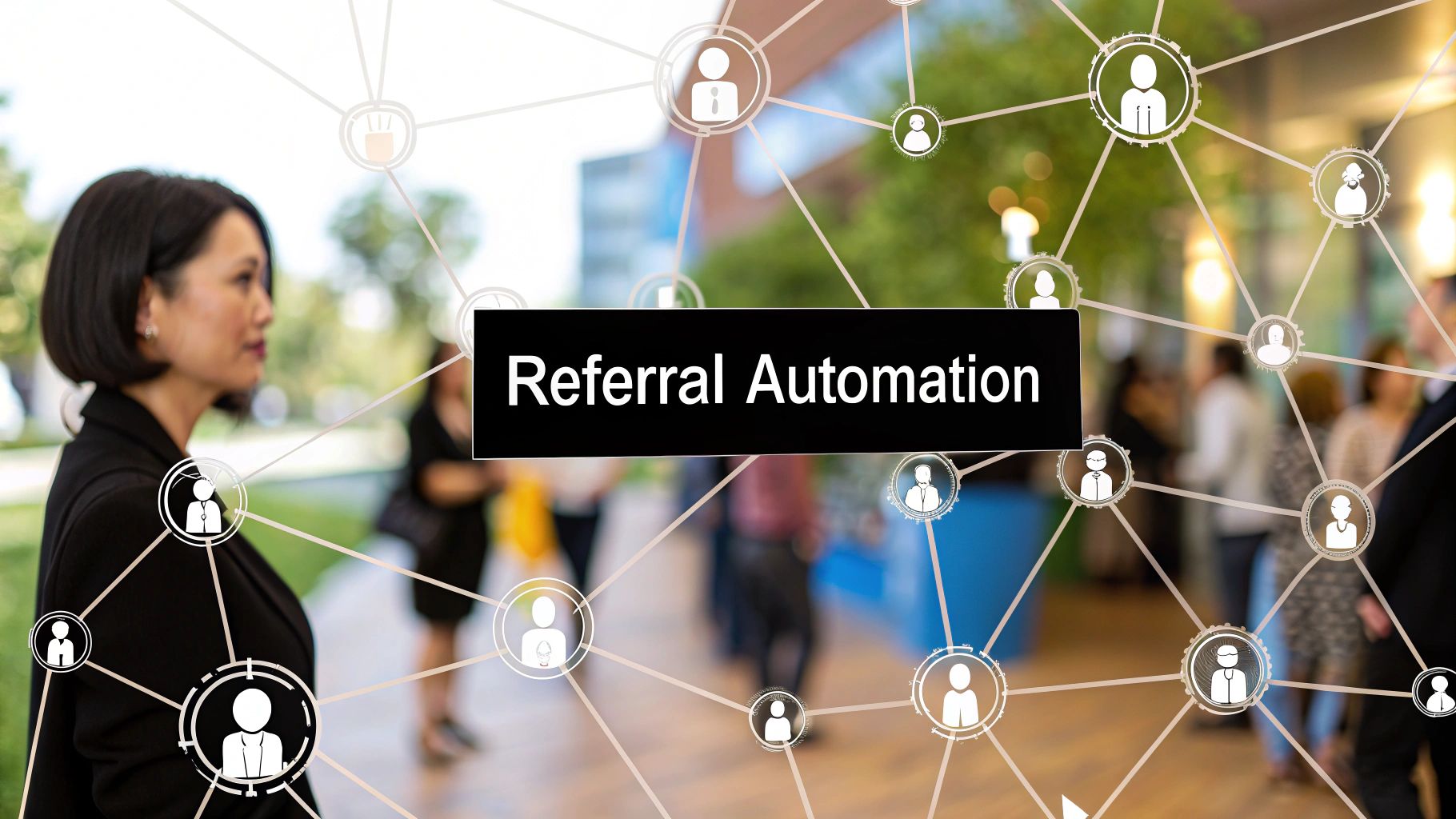The Evolution of Modern Automated Referral Programs
Referral programs have always been a valuable tool for business growth. Traditionally, managing these programs involved manual processes like spreadsheets and emails, creating significant administrative overhead. This made scaling referral initiatives challenging and time-consuming. However, the arrival of automated referral programs has changed how businesses approach referral marketing.
This shift toward automation is a major advancement. Automated referral programs streamline the entire referral process, from invitation and signup to reward distribution and performance tracking. Consider a SaaS business that previously tracked referrals manually. With automation, the business can seamlessly integrate the referral program into its platform, automatically tracking referrals, issuing rewards, and analyzing key metrics. This increased efficiency frees up valuable time and resources, allowing businesses to concentrate on other important growth activities.
Benefits of Automation in Referral Programs
Automated referral programs provide several advantages over manual programs. Key benefits include:
- Increased Efficiency: Automation eliminates manual tasks, freeing up time and resources.
- Improved Accuracy: Automated systems reduce errors in tracking and reward distribution.
- Scalability: Automated programs can easily handle growth as the number of referrals increases.
- Enhanced Customer Experience: Automated programs offer a smooth and user-friendly experience for both referrers and referred customers.
- Data-Driven Insights: Automation provides valuable data and analytics that can be used to optimize the program.
The Impact of Automation on ROI
The move toward automation has a measurable impact on the return on investment (ROI) of referral programs. These programs have significantly changed customer acquisition strategies, especially in the SaaS and tech sectors. Referred customers are expected to spend 25% more than non-referred customers and are 27% more likely to stay loyal in 2025. More detailed statistics can be found here. The cost-effectiveness of referral programs is further enhanced by high conversion rates, which are typically higher than other marketing channels. This allows businesses to acquire high-quality customers at a lower cost, maximizing ROI.
Key Features of Modern Automated Referral Programs
Modern automated referral programs include features designed to maximize program success:
- Seamless Integration: Integration with existing CRM, email marketing, and other platforms.
- Customizable Rewards: Flexibility in offering different reward types, such as discounts, cash, or exclusive content.
- Automated Communication: Personalized email and in-app messages keep participants engaged.
- Real-Time Tracking and Reporting: Detailed analytics help monitor program performance and pinpoint areas for improvement.
- Fraud Detection: Mechanisms are in place to prevent fraudulent referral activity.
These features enable businesses to create effective referral programs that generate sustainable growth. By automating key processes and using data-driven insights, businesses can fully realize the potential of their referral marketing efforts.
Building Blocks of High-Converting Referral Programs

The infographic above depicts a marketing team analyzing performance charts. This highlights the important role of ROI in referral programs. The visualization emphasizes a data-driven approach. Such an approach is essential for optimizing and boosting returns from automated referral programs. Analyzing program performance allows businesses to pinpoint areas for improvement and maximize program effectiveness.
An effective automated referral program requires more than just automation. It needs a deep understanding of what motivates customers. It also relies on the strategic implementation of several key elements. This means going beyond automating the technical aspects. It means focusing on what truly drives customer advocacy.
Motivating Customer Advocacy
A core building block of any successful referral program is a compelling reward structure. While discounts or cash bonuses are common, businesses should explore other options. Creative incentives that align with the brand and target audience can be highly effective.
Consider tiered rewards to further motivate consistent referrals. Offering increasingly valuable rewards for multiple referrals can significantly boost participation. However, rewards alone are not enough. Building genuine customer connections through personalized communication is equally critical.
Frictionless Sharing Experience
The easier referring friends is for customers, the more likely they are to participate. Minimize the steps involved in the referral process. Integrate sharing options directly within the customer journey.
Providing pre-written referral messages can also simplify things. This removes the sometimes difficult task of crafting compelling invitations. This streamlined approach reduces friction. It encourages more frequent referrals. Check out this article on How to master referral program best practices for more detailed guidance. Staying informed about the latest strategies is important, including insights on email automation best practices.
Effective Communication Strategies
Personalized communication throughout the referral lifecycle is vital. This includes tailored welcome emails. It also means sending timely reminders and personalized thank you messages. Segmenting your audience based on referral activity allows for targeted communication. This resonates better with each individual.
This approach fosters stronger customer relationships. It encourages ongoing participation in the referral program. Crafting compelling and personalized messages at each stage is key. This targeted approach will maximize both participation and conversions.
To understand the key differences between managing referrals manually and with automation, take a look at the comparison table below. It illustrates the various components and the benefits of automating your referral program.
| Component | Manual Referral Program | Automated Referral Program | Business Impact |
|---|---|---|---|
| Tracking Referrals | Spreadsheets, manual entry, prone to errors | Real-time tracking, automated reports | Increased accuracy, saved time and resources |
| Reward Distribution | Manual processing, delays, potential for mistakes | Automated payouts, instant gratification | Improved customer satisfaction, reduced administrative overhead |
| Communication | Individual emails, time-consuming | Automated emails, personalized messaging | Enhanced engagement, scalable communication |
| Fraud Detection | Difficult to monitor, potential for abuse | Built-in fraud prevention measures | Reduced risk, protected program integrity |
| Program Management | Complex administration, requires dedicated resources | Simplified management, easy to monitor | Increased efficiency, improved program scalability |
Automating your referral program significantly streamlines operations. It leads to increased efficiency and improved customer satisfaction. The table clearly demonstrates the advantages of automation across various program components.
Launching Your Automated Referral Program: A Practical Roadmap
Launching an automated referral program isn't just about activating software; it's a strategic initiative. This roadmap outlines the essential steps for building a sustainable growth engine through referrals. It requires careful planning, the right technology, and a deep understanding of your audience.
Defining Your Objectives and Target Audience
Before implementation, clearly define your program's goals. Are you focused on increasing customer acquisition, boosting brand awareness, or driving customer loyalty? Establishing measurable objectives, such as a target referral rate or a desired increase in customer lifetime value, will guide your strategy and allow you to track progress.
Identify your ideal referrer. Which customer segments are most likely to refer others? Understanding their motivations and preferred communication channels is crucial for tailoring your program. For example, if your target audience is active on social media, prioritize social sharing features within your referral program.
Selecting the Right Technology Partner
Choosing the right referral software is a critical decision. Factors such as your business stage, integration requirements, and growth projections will influence your choice. A startup might prioritize a simple solution like Refgrow, offering seamless embedding and quick setup. Larger enterprises might require more robust platforms with advanced features like multi-tiered rewards and complex fraud detection.
Evaluate platforms based on their integration capabilities with your existing tech stack, such as your CRM and email marketing software. This ensures a streamlined workflow and avoids data silos. Consider essential features like automated communication, real-time tracking, and customizable reward options. Refgrow, for instance, provides automated conversion tracking through integrations with payment gateways like Stripe and Lemon Squeezy.
Designing Engaging Program Mechanics
Crafting compelling program mechanics is key to driving participation. Consider offering a variety of reward options, such as discounts, cash bonuses, or exclusive content, to cater to different preferences. Tiered rewards, where referrers earn increasingly valuable rewards for multiple referrals, can further incentivize participation.
The referral process should be frictionless. Minimize the steps required for a customer to refer a friend, and integrate social sharing options directly within the customer journey. Refgrow's embeddable design simplifies integration, creating a user-friendly experience.
Integrating With Your Existing Tech Stack
A successful automated referral program relies on seamless integration with your existing tools. Prioritize platforms that offer robust API integrations or pre-built connectors with your CRM, email marketing software, and other essential systems. This eliminates manual data entry and ensures consistent communication across platforms. Be mindful of potential integration pitfalls, such as data mapping discrepancies, and address these proactively. Refgrow’s robust REST API provides flexibility and streamlines integration.
Launching and Promoting Your Program
Once your program is set up, it's time to launch and promote it. Announce your program through various channels, such as email newsletters, social media posts, and in-app notifications.
- Run a pilot program with a small group of customers to gather feedback before a full-scale launch.
- Offer early-bird bonuses to create excitement and generate early momentum.
Launching a referral program is an ongoing process. Continuously monitor program performance, gather customer feedback, and make adjustments as needed to optimize your referral strategy. Learn how to scale referral-based growth without ad spend on the Refgrow blog.
Measuring What Matters: Optimizing Your Automated Referral Program

For a truly successful automated referral program, looking beyond surface-level metrics is essential. This means developing a performance framework focused on driving real improvements, not just counting referrals. Instead, prioritize the metrics that have a direct impact on your bottom line.
Key Performance Indicators (KPIs) for Referral Programs
Forget vanity metrics. Concentrate on these key performance indicators (KPIs):
Referral Rate: This KPI measures the percentage of your existing customers who refer new business. A higher referral rate indicates strong customer satisfaction and positive word-of-mouth. Tracking this metric helps you understand how effectively your program motivates referrals.
Conversion Rate: This is the percentage of referred leads who become paying customers. A high conversion rate suggests excellent lead quality and effective targeting. It's a crucial metric for evaluating the overall effectiveness of your referral program.
Customer Lifetime Value (CLV) of Referred Customers: Compare the CLV of referred customers to the CLV of customers acquired through other channels. Referred customers often have a higher CLV due to increased trust, strengthening the argument for investing in referrals.
Cost Per Acquisition (CPA) from Referrals: Calculate the cost of acquiring a customer through referrals and compare it to other marketing channels. This helps determine the cost-effectiveness of your referral program. Tools like Refgrow can help scale your referral program without increasing ad spend, potentially lowering your CPA.
Return on Investment (ROI): This is the ultimate measure of success, comparing the revenue generated by your referral program to its operating costs. A strong ROI demonstrates the value and efficiency of your referral efforts.
To help you understand these KPIs and how to optimize them, we've compiled the following table:
Essential Metrics for Automated Referral Program Success
This table outlines the key performance indicators (KPIs) that businesses should track to measure the effectiveness of their automated referral program.
| Metric | Definition | Target Range | Optimization Actions |
|---|---|---|---|
| Referral Rate | Percentage of existing customers making referrals | 10-20% | Improve incentive structure, simplify referral process |
| Conversion Rate | Percentage of referred leads converting to paying customers | 20-30% | Optimize targeting, personalize messaging |
| CLV of Referred Customers | Average lifetime value of a referred customer | 1.5x-2x higher than other channels | Enhance onboarding, offer exclusive rewards |
| CPA from Referrals | Cost of acquiring a customer through referrals | Lower than other channels | Streamline the referral process, leverage automation |
| ROI | Overall return on investment for the referral program | > 100% | Continuously test and optimize all elements |
This table provides a framework for analyzing your referral program's performance. By tracking these KPIs and implementing the suggested optimization actions, you can significantly improve your results.
Implementing Continuous Testing and Optimization
The most successful automated referral programs are dynamic, not static. They employ continuous testing to improve conversion rates at every stage. This involves A/B testing elements like:
Incentive structures: Experiment with different rewards to find what motivates your audience.
Call to action (CTA) messaging: Refine your CTA to encourage more clicks and referrals.
Referral process flow: Simplify the referral process to reduce friction and boost participation. Refgrow's easy integration can create a seamless experience.
Identifying and Nurturing High-Value Referrers
While all referrers are valuable, some consistently deliver high-quality leads. Identify these high-value referrers through data analysis and nurture these relationships. Offer exclusive rewards, personalized communication, and early access to new features.
Leveraging Referral Platform Analytics
Referral platforms like Refgrow often provide in-depth analytics. These offer insights into referral patterns, bottlenecks, and high-performing segments. Use this data to uncover hidden optimization opportunities. For example, identify high-performing referral sources or the most effective referral messages.
By focusing on the right metrics and continuously optimizing your program, your automated referral program can become a powerful engine for sustainable growth. This data-driven approach maximizes ROI and achieves long-term success.
Selecting Technology That Powers Referral Growth
Choosing the right platform for your automated referral program is crucial for its long-term success. The market offers a variety of options, each with its own advantages and disadvantages. Understanding your business needs and having a practical evaluation framework are essential for navigating these choices.
Evaluating Referral Software Beyond Feature Lists
Don't be swayed by long feature lists alone. Instead, focus on how well a platform aligns with your specific growth objectives. A startup with limited resources might prioritize ease of integration and affordability. A larger enterprise, however, might require more advanced features like multi-tiered rewards and robust fraud detection.
Essential Capabilities for Different Business Models
Different business models require different functionalities. A B2C e-commerce business might prioritize social sharing features, while a B2B SaaS company might focus on integrations with CRM platforms like Salesforce. Consider your target audience and their preferred communication channels to ensure your chosen platform effectively reaches and engages potential referrers. You might be interested in: How to master program setup with Refgrow.
Integration Capabilities and Operational Efficiency
Seamless integration with your existing technology is paramount. Look for platforms offering robust APIs or pre-built connectors with your CRM, email marketing software, and other critical systems. This avoids data silos and streamlines your workflow, creating operational efficiencies. Ensure the platform also supports your preferred reward delivery methods, whether automated discounts, gift cards, or other incentives. The global referral management market is projected to reach $10.82 billion by 2029, highlighting the growing importance of automated solutions. Find more detailed statistics here.
Advanced Features and Pricing Considerations
Some platforms offer advanced features such as AI-powered personalization or predictive analytics. While potentially valuable, carefully assess if they justify premium pricing. Focus on features directly contributing to your core objectives, rather than paying for extras you won't use.
Implementation Considerations and Resource Requirements
Beyond the software itself, consider the implementation process. Factor in data migration requirements, training needs for your team, and ongoing vendor support. Assess the platform's data security measures and compliance certifications, ensuring they meet your organization's standards. Choosing a platform like Refgrow that offers seamless embedding and quick setup can significantly reduce implementation time and resource requirements. This allows you to launch your automated referral program quickly and efficiently.

Amplifying Growth Through Strategic Referral Partnerships
Automated referral programs are powerful tools for business growth. However, combining these programs with strategic partnerships significantly expands their potential. These collaborations offer synergistic opportunities to broaden your reach and connect with entirely new customer bases. The key is to identify businesses that complement your offerings and target a similar ideal customer profile without directly competing with your core products or services.
Identifying Synergistic Partnership Opportunities
The initial step involves identifying potential partners. Focus on businesses that cater to the same target audience as yours, but offer distinct products or services. For instance, if your company sells project management software, a potential partner might be a company offering time-tracking tools or virtual assistant services. This creates a natural cross-promotion opportunity, allowing each business to refer customers to the other.
Structuring Mutually Beneficial Agreements
After identifying potential partners, establishing clear partnership agreements is crucial. These agreements should outline the terms of the referral relationship. Be sure to include details on how referrals are tracked, the incentive structure for both parties, and any planned co-marketing efforts. This transparency helps build a strong, mutually beneficial foundation for a lasting partnership.
Automating Multi-Party Referral Tracking
Managing referrals across multiple partners can become complicated. Automated systems are essential for accurately and efficiently tracking referrals. Refgrow, for example, offers a robust API and flexible integration options that facilitate seamless tracking, even within complex partnership scenarios. This automation removes the burden of manual tracking, allowing you to scale your partnerships effectively. Referral marketing is a significant growth driver, with 60% of referrals originating from strategic partnerships, showcasing their power to amplify program reach. Learn more about referral marketing statistics here.
Building Long-Term Referral Ecosystems
Think of strategic partnerships as more than just transactional referral agreements. Nurture these relationships to cultivate integrated growth ecosystems. Consider joint webinars, co-branded content creation, or shared customer events. By collaborating on initiatives beyond simple referrals, you create greater value for your customers and strengthen your partnerships. To help streamline the process, explore options for Automating the Testimonial Collection Process.
Approaching Potential Partners and Structuring Incentives
When approaching potential partners, clearly communicate the mutual benefits of the partnership. Emphasize how combining your offerings provides increased value to customers. Design incentive structures that align with both partners' objectives. This might involve reciprocal referral bonuses, revenue sharing, or joint investments in co-marketing activities.
Nurturing Relationships for Sustainable Growth
Maintain open communication with your partners, sharing performance data and identifying areas for improvement. Regularly review the partnership agreement to ensure it continues to align with both businesses' evolving needs. By investing in these relationships, you can transform simple referrals into robust, long-term growth engines for sustained success.
The Future of Automated Referral Programs: Emerging Trends
Automated referral programs are no longer a new idea; they're essential for business growth. However, the referral landscape is constantly changing, with new technologies and strategies reshaping how businesses use the power of customer advocacy. Staying ahead of the curve is vital for maximizing the ROI of your referral marketing efforts.
AI-Powered Personalization
Artificial intelligence (AI) is transforming referral programs by enabling a level of personalization previously impossible. AI algorithms analyze past behavior, purchase history, and social media activity to predict the most effective incentives for each referrer. This could involve offering a discount on a product a customer viewed or suggesting a reward tailored to their interests. Artificial intelligence is key to driving engagement and higher conversion rates. You might be interested in: How to master SaaS referral program growth.
Integrating Referrals Into Broader Advocacy Ecosystems
Leading companies are integrating referral programs into larger advocacy ecosystems. These ecosystems include customer reviews, social sharing, and user-generated content. For instance, a customer leaving a positive review could be automatically invited to the referral program. This holistic approach creates a powerful network of advocates, amplifying your brand message across many channels.
Blockchain for Enhanced Transparency and Trust
Blockchain technology enhances referral programs with transparent and tamper-proof tracking systems. This builds trust with participants by ensuring accurate referral records. Blockchain’s immutability eliminates disputes over rewards and builds confidence in the program. This is especially important as privacy regulations increase. Blockchain Technology is an emerging area that businesses are increasingly exploring.
Navigating the Cookieless Future
Changes in privacy regulations, like the decline of third-party cookies, are changing referral strategies. Forward-thinking companies are focusing on first-party data and building direct customer relationships. This involves email marketing, personalized in-app messages, and other privacy-compliant methods to promote referral programs.
Bridging Digital and Physical Experiences
New channel strategies are blending digital and physical referral experiences. Imagine a retail store offering a unique QR code for in-store referrals, linked to the online program. This integrated approach connects online and offline customer journeys, maximizing participation and creating a seamless brand experience. This omnichannel strategy caters to different customer preferences and expands your program's reach.
Ready to transform your referral marketing? Refgrow offers fully embeddable affiliate software designed for SaaS businesses. Learn more about how Refgrow can help you scale your referral program.

